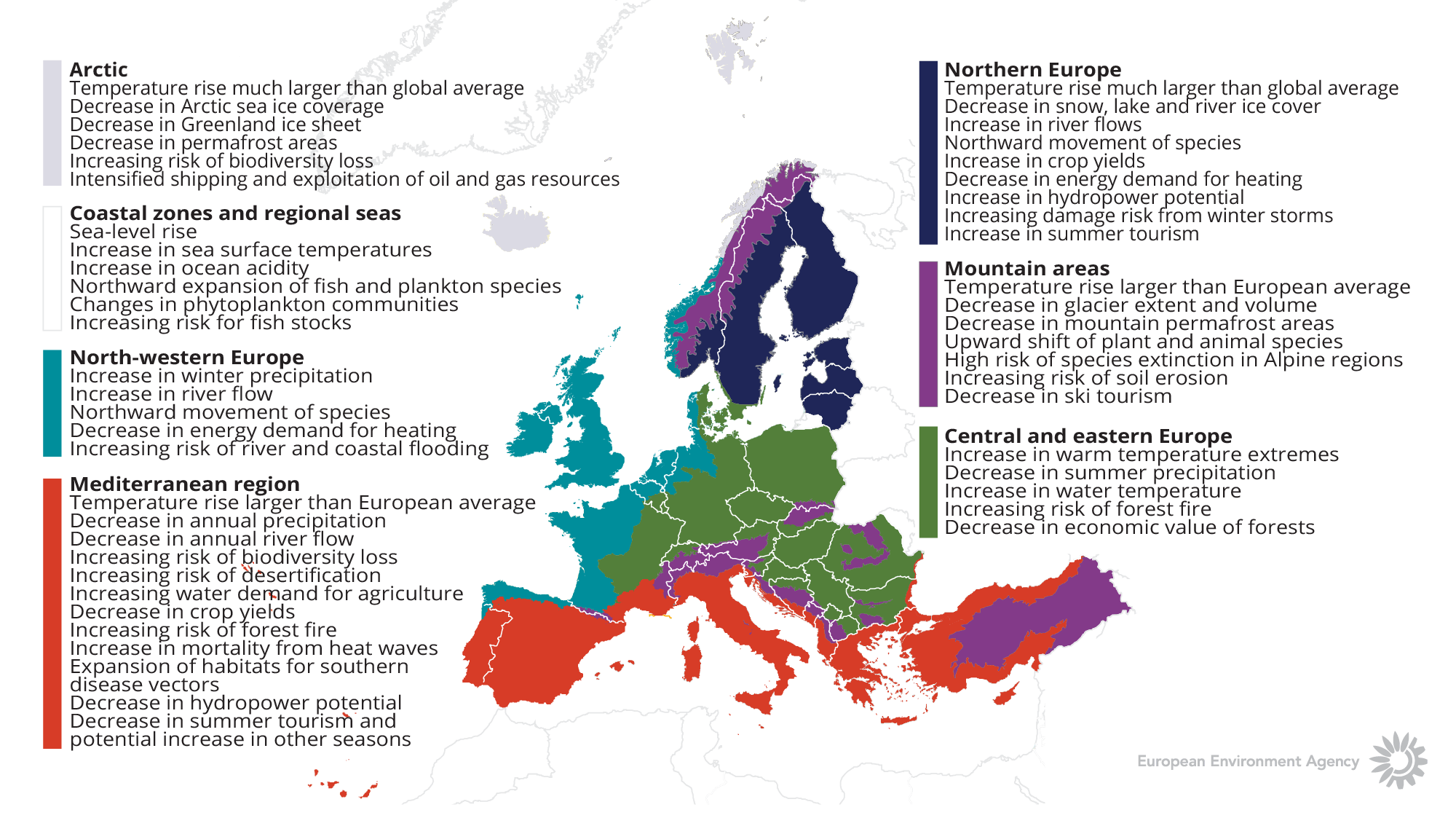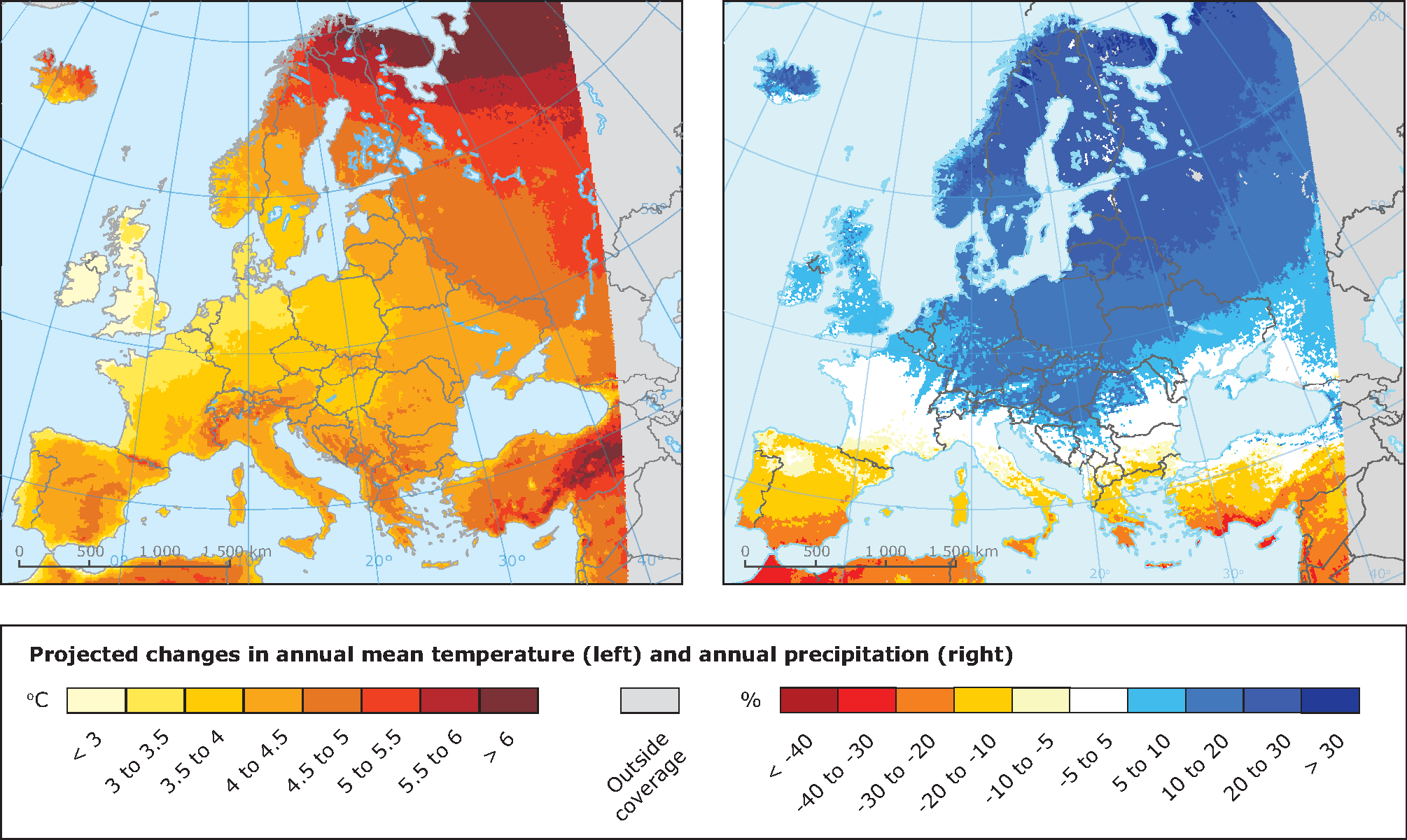Context
Climate change has already led to a wide range of impacts on the environment, the economy, and society.[1][2] These impacts have been felt both in Europe and across the world. Even if greenhouse gas (GHG) emissions were to stop today, climate change would continue for many decades as a result of past emissions and the inertia of the climate system.[2] It is therefore necessary to adapt to the changes that have already occurred and to prepare for plausible scenarios of future climate change.
To help promote this adaptation, the European Commission in 2013 adopted the communication 'An EU Strategy on adaptation to climate change'.[3] The communication supports adaptation actions in countries, and promotes better research and information-sharing. It also supports 'mainstreaming', the process whereby adaptation concerns are integrated into existing sectoral EU policies (like agriculture or regional development). Overall it aims to help make Europe more climate-resilient, enhancing its capacity to respond to the impacts of climate change at local, regional, national, and EU levels.
Adaptation is also considered in other EU initiatives, particularly Europe 2020 — Europe's growth strategy,[4] and the Resource-Efficient Europe flagship initiative.[5] Moreover, a new international climate change agreement is expected to be negotiated by the end of 2015. Several adaptation-related elements of such an agreement are currently being discussed. These include capacity building, institutional arrangements, financing, incentives for private investments, and provisions promoting transparency through monitoring, reporting and verification.
Key trends
Climate change impacts
Human influence — primarily emissions of greenhouse gases, but also changes in land use — has been the dominant cause of the observed warming since the mid-20th century. The last decade was the warmest since global temperature records became available. Climate change impacts can be seen in accelerating global sea-level rise, in changes in various climate extremes and in changes in the global water cycle. Precipitation has generally increased in northern and north-western Europe, but has generally decreased in southern Europe. Snow cover in Europe has been decreasing, and the extent and volume of Arctic sea ice have been decreasing much faster than previously projected[1][2] (see SOER 2015 briefing on the air and climate system; and on climate change).
Observed climate change has already led to a wide range of impacts on environmental systems, economic sectors, and human health and well-being in Europe. These impacts vary across Europe depending on climatic, geographic and socio-economic conditions. Figure 1 shows key observed and projected impacts from climate change for the main biogeographical regions in Europe.

Source: EEA (2012)
Adaptation
These climate change impacts have spurred policymakers at national and European level to introduce adaptation policies that will help societies and economies to cope with the effects of climate change and socio-economic changes.
On a European level, 'mainstreaming' of climate change adaptation is taking place within various EU policies, such as freshwater and coastal management, biodiversity and nature protection, and disaster-risk reduction.[6][7]
In order to assist the development of adaptation policies in Europe, the EU maintains a website, the European Climate Adaptation Platform (Climate-ADAPT). Climate-ADAPT enhances the sharing of up-to-date, reliable, and targeted information and data. It supports the development and implementation of adaptation policies across all levels of governance in Europe, for example by providing examples of adaptation options, case studies of implemented actions, and an adaptation-support tool.
On the national level — and at the city and regional levels — implementing adaptation is still at an early stage.[8][9] Most progress has been reported for freshwater management, flood-risk management, and agriculture. The adaptation actions in these sectors have mostly consisted of 'mainstreaming' adaptation priorities into these national sectoral policy areas.
Although adaptation implementation is still at an early stage, adaptation planning work is underway in most countries. As of June 2014, 20 EEA member countries have adopted national adaptation strategies (13 more than in 2008). 17 of these countries have also developed an adaptation national action plan to help further define the adaptation actions they will implement.[7]
Most European countries report that the level of public awareness regarding the need for adaptation has increased during the past five years and that adaptation has reached the national political agenda.
On a transnational level, adaptation action is mainly the result of shared natural resources such as transboundary water catchments. Transnational cooperation of this sort is often supported by European funding instruments (e.g. in the Baltic Sea region) and through European regional conventions (e.g. the Danube Commission).
Prospects
Climate change impacts
In the long term, the magnitude and rate of climate change depends on future global greenhouse gas emissions. The European Union is committed to limiting global temperature increase to below 2 °C above the pre-industrial level, as agreed globally under the UNFCCC. However, the projected rise in global average temperatures over the 21st century is 0.3 °C–1.7 °C for the lowest emission scenario, and 2.6 °C–4.8 °C for the highest emission scenario.[2]

Source: Climate change projections for Europe based on an ensemble of regional climate model simulations provided by the EURO-CORDEX initiative.
Note: Projected changes are for 2071-2100, compared to 1971-2000, based on the average of a multi-model ensemble forced with the Representative Concentration Pathways (RCP) 8.5 high emissions scenario. All changes marked with a colour (i.e. not white) are statistically significant. Individual models from the EURO-CORDEX ensemble or high-resolution models for smaller regions may show different results.
Indicators: Global and European temperature (CSI 012), Mean precipitation (CLIM 002).
Annual average land temperatures over Europe are projected to continue increasing by more than the global average temperature. The largest temperature increases are projected over eastern and northern Europe in winter, and over southern Europe in summer. Annual precipitation is generally projected to increase in northern Europe and to decrease in southern Europe, thereby enhancing the differences between currently wet regions and currently dry regions (Figure 2). The intensity and frequency of extreme weather events is also projected to increase in many regions, and sea-level rise is projected to accelerate significantly.[1]
Climate change may increase existing vulnerabilities and deepen socio-economic inbalances in Europe. Major climate risks for Europe include increased coastal and river floods, significant reduction in water availability, and extreme heat events.[10] According to a recent study, under a high-emission scenario and in the absence of adaptation actions, some climate impacts would roughly double by the end of this century. Heat-related deaths would reach about 200 000 per year; the cost of river flood damages would exceed EUR 10 billion/year; and every year forest fires would affect an area about 800 000 ha. In this scenario, people affected by droughts would also increase by a factor of seven to about 150 million per year, and welfare loss due to sea-level rise would more than triple to EUR 42 billion/year.[11]
Adaptation
Adaptation policy at the European level will receive new financial resources in the coming years. 20% of the EU budget for 2014–2020 will be used for climate-related actions (i.e. adaptation and climate-change mitigation). This funding will be disbursed to Member-State level through a range of EU funds such as the European Regional Development and Cohesion Funds, European Structural and Investment funds, LIFE+ projects, and the INTERREG regional cooperation funds.[12][7]
In 2017, the European Commission will report to the European Parliament and the Council on the state of implementation of the 2013 communication 'An EU Strategy on adaptation to climate change', and will propose its review if needed.
Assessment processes are also in place at national level, and will lead to better knowledge in the future about effective adaptation. Four European countries are currently implementing a monitoring, reporting or evaluation scheme. Nine countries have already developed — or are developing — indicators on climate change impacts, risks or adaptation.
Climate change risk or vulnerability assessments are available for 21 European countries, but more information is still needed, particularly on the estimated benefits and costs of different adaptation options. Another area that requires more research is the issue of how best to craft adaptation responses in the light of uncertainty concerning future climate change impacts, societal change, and the effectiveness of adaptation responses.
Document Actions
Share with others